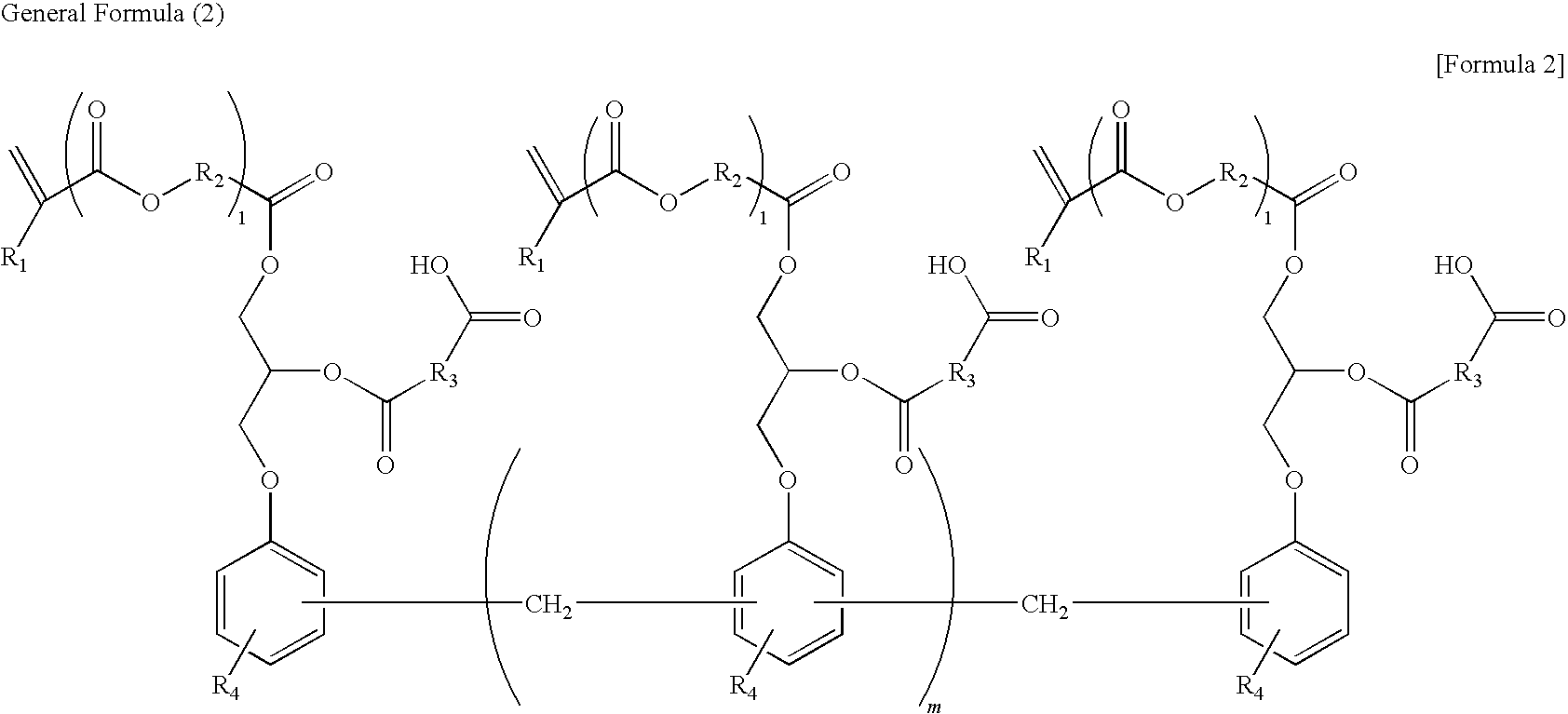Photosensitive resin composition
a technology of resin composition and resist, which is applied in the direction of photosensitive materials, instruments, photomechanical equipment, etc., can solve the problems of not avoiding a reduction in alkali developability, insufficient curability, and reducing exposure energy during solder resist patterning, etc., to achieve excellent curability, excellent developability, and excellent sensitivity to actinic energy rays.
- Summary
- Abstract
- Description
- Claims
- Application Information
AI Technical Summary
Benefits of technology
Problems solved by technology
Method used
Image
Examples
example 1
Preparation of a Resin Solution (A-1) Including an Acid Group-Containing Vinyl Ester Resin (A)
[0093]To 1923 g of diethylene glycol monoethyl ether acetate, 2140 g of an ortho-cresol novolak-type epoxy resin [“EPICLON N-695” manufactured by Dainippon Ink and Chemicals, Inc., softening point: 95° C., epoxy equivalent: 214, average number of functional groups: 7.6] (number of the glycidyl groups (total number of the aromatic rings): 10.0 moles), 720 g (10.0 moles) of acrylic acid, and 2.9 g of hydroquinone were added, and the mixture was heated while stirring to 100° C. for uniform dissolution. After that, 8.6 g of triphenyl phosphine were added thereto, and the mixture was heated to 110° C. to perform a reaction for 2 hours, and then, 2.3 g of triphenyl phosphine was further added to the mixture. The temperature of the mixture was elevated to 120° C. to perform a reaction for 12 hours. To the obtained reaction solution, 1923 g of an aromatic hydrocarbon (“SolvEsso 150”) and 1368 g (9....
example 2
Preparation of a Resin Solution (A-2) Including an Acid Group-Containing Vinyl Ester Resin (A)
[0095]To 197 g of diethylene glycol monoethyl ether acetate, 214 g of an ortho-cresol novolak-type epoxy resin “EPICLON N-695” (number of the glycidyl groups (total number of the aromatic rings): 1.0 mole), 72 g (1.0 mole) of acrylic acid, and 0.29 g of hydroquinone were added, and the mixture was heated while stirring to 100° C. for uniform dissolution. After that, 0.86 g of triphenyl phosphine were added thereto, and the mixture was heated to 110° C. to perform a reaction for 2 hours, and then, 0.23 g of triphenyl phosphine was further added to the mixture. The temperature of the mixture was elevated to 120° C. to perform a reaction for 12 hours. To the obtained reaction solution, 197 g of “SolvEsso 150” and 144 g (0.95 mole) of tetrahydrophthalic anhydride were added to perform a reaction at 110° C. for 4 hours. Furthermore, to the obtained reaction solution, 121 g (0.85 moles) of glycid...
example 3
Preparation of a Resin Solution (A-3) Including an Acid Group-Containing Vinyl Ester Resin (A)
[0096]To 213 g of diethylene glycol monoethyl ether acetate, 214 g of an ortho-cresol novolak-type epoxy resin “EPICLON N-695” (number of the glycidyl groups (total number of the aromatic rings): 1.0 mole), 72 g (1.0 mole) of acrylic acid, and 0.29 g of hydroquinone were added, and the mixture was heated while stirring to 100° C. for uniform dissolution. After that, 0.86 g of triphenyl phosphine were added thereto, and the mixture was heated to 110° C. to perform a reaction for 2 hours, and then, 0.23 g of triphenyl phosphine were further added to the mixture. The temperature of the mixture was elevated to 120° C. to perform a reaction for 12 hours. To the obtained reaction solution, 213 g of “SolvEsso 150”, 274 g (1.8 moles) of tetrahydrophthalic anhydride and 135 g (0.95 mole) of glycidyl methacrylate were added to perform a reaction at 115° C. for 8 hours, thereby obtaining a resin solut...
PUM
| Property | Measurement | Unit |
|---|---|---|
| acid value | aaaaa | aaaaa |
| softening point | aaaaa | aaaaa |
| softening point | aaaaa | aaaaa |
Abstract
Description
Claims
Application Information
 Login to View More
Login to View More - R&D
- Intellectual Property
- Life Sciences
- Materials
- Tech Scout
- Unparalleled Data Quality
- Higher Quality Content
- 60% Fewer Hallucinations
Browse by: Latest US Patents, China's latest patents, Technical Efficacy Thesaurus, Application Domain, Technology Topic, Popular Technical Reports.
© 2025 PatSnap. All rights reserved.Legal|Privacy policy|Modern Slavery Act Transparency Statement|Sitemap|About US| Contact US: help@patsnap.com



